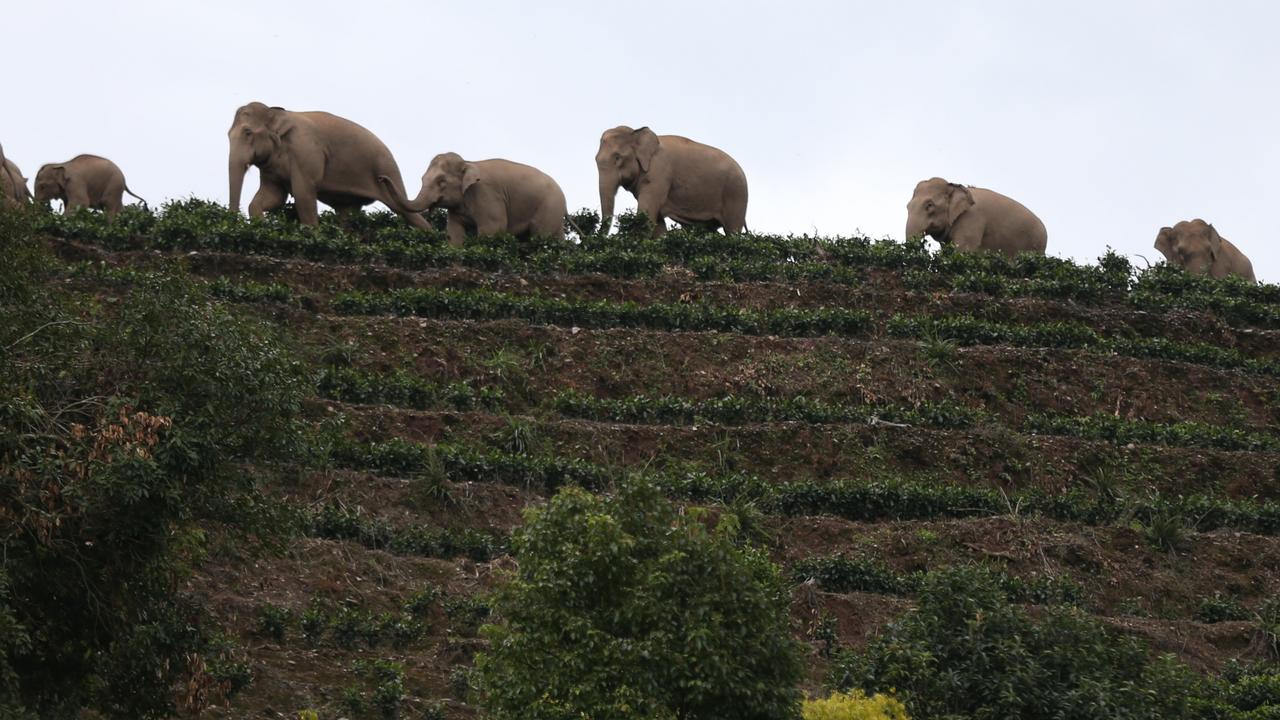Chinese herd making tracks for World Elephant Day homecoming
After an epic journey followed by millions of fans around the world, China’s weary herd of wandering elephants is homeward bound ahead of World Elephant Day

READING LEVEL: GREEN
China’s famous herd of wandering wild elephants is heading home after a 17-month walkabout that has baffled zoologists* and caused chaos in towns and villages along the way.
The animals ambled* more than 480km north from a forest in the southwestern province of Yunnan to reach Kunming, the capital, before turning around and heading home. One of the females even gave birth along the way.
The 14 remaining Asian elephants were guided across the Yuanjiang river in Yunnan on the night of Sunday 8 August and a path is being opened for them to return to the nature reserve where they usually live on the border of Myanmar and Laos. The herd is now in Yuanjiang county, about 200km from the reserve.
Experts do not know what caused the elephants to undertake the journey, which was closely monitored to alert people in their path so that villagers could get out of way, avoid injury and protect their crops and property where possible.

Wildlife rangers left food at regular stops to try to guide them away from built-up areas and eventually to tempt the elephants home.
The herd, initially made up of 16 elephants, left home in March last year. The calf was born in December and the group made it to Kunming, a city of about 4.4 million people, by early June.
During the trek two elephants left to begin solo adventures. One was later tranquillised and taken home in July.
Experts have suggested that the most likely explanation for what seems to be an aimless* trek is that the rainforests they rely on are shrinking around them. Suitable food sources may have become harder to find because of the growing number of rubber tree and tea plantations that have sprung up in the area.
Others suggest that a magnetic storm caused by abnormal solar activities started the migration.

WORLD ELEPHANT DAY
Elephants rescued from Indian circuses and temples were treated to a feast of their favourite fruits and vegetables to celebrate World Elephant Day.
A lavish spread of watermelons, bananas, papayas and pumpkins was laid out for the Asian elephants at a sanctuary near the banks of the Yamuna River, on the outskirts of the ancient holy city of Mathura.
The centre observes a week of events surrounding World Elephant Day on Friday 12 August.
Most of the 28 elephants at the centre have chronic illness and various health issues ranging from abscesses*, cataracts*, blindness and joint pain after living in captivity, said conservationists with Wildlife SOS, which operates the sanctuary.
“World Elephant Day is there to promote awareness about the plight of elephants in India and around the world, and what they actually go through and why their population is declining,” said Shirina Sawhney from Wildlife SOS, which also runs India’s only elephant hospital.
Elephants are an important part of Indian culture and are often seen during festivals and processions in the country’s south. They are also used in the north and west as tourist attractions at several forts and palaces.
While revered* as cultural and religious icons, elephants are also mistreated, and continue to be victims of electrocution, poaching*, train accidents and poisoning.
The number of wild Asiatic elephants, primarily found in India and parts of South and Southeast Asia, has fallen to under 50,000, just 15 per cent of its historic average, according to the World Wide Fund for Nature.
Main story originally published in The Times and is reprinted with permission.
GLOSSARY
- zoologists: animal experts
- ambled: walked or moved at a slow, relaxed pace
- aimless: without purpose, meaning or direction
- lavish: generous, special, elaborate
- abscess: pus build up in body tissue
- cataracts: clouding of the eye lens
- revered: deeply respected and admired
- poaching: illegally taking wild animals or plants
EXTRA READING
China’s wandering elephants become global stars
World’s loneliest elephant free to find friends
Animals lend a helping hand at the zoo
QUICK QUIZ
- How long has the herd of elephants been on the move across China’s Yunnan province?
- How many kilometres have they travelled?
- Why were people in their path alerted that the elephants were coming?
- What do experts suggest is the most likely explanation for the herd’s travels?
- When is World Elephant Day?
LISTEN TO THIS STORY
CLASSROOM ACTIVITIES
1. Welcome home!
What do you think would make a great “welcome home” event for the elephants? Create a plan of activities that will celebrate the end of this epic journey at their nature reserve and celebrate World Elephant Day.
Time: allow 20 minutes to complete this activity
Curriculum Links: English
2. Extension
Two of the elephants left the trek “ … to embark on solo adventures.” Rewrite today’s story from the point of view of one of these elephants.
Time: allow 25 minutes to complete this activity
Curriculum Links: English; Critical and Creative Thinking; Science
VCOP ACTIVITY
Grammar and VCOP
The glossary of terms helps you to understand and learn the ambitious vocabulary being used in the article. Can you use the words outlined in the glossary to create new sentences? Challenge yourself to include other VCOP (vocabulary, connectives, openers and punctuation) elements in your sentence/s. Have another look through the article, can you find any other Wow Words not outlined in the glossary?

